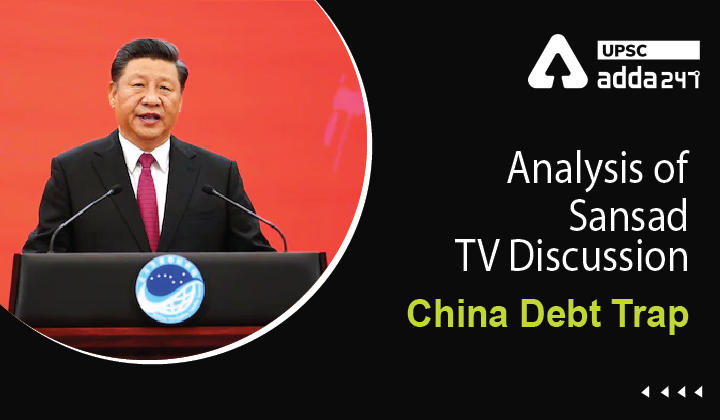Table of Contents
Analysis Of Sansad TV Discussion
”China Debt Trap”
Relevance
”GS 2: India and its Neighbourhood, Bilateral Groupings & Agreements, Groupings & Agreements Involving India and/or Affecting India’s Interests, Effect of Policies & Politics of Countries on India’s Interests”
Context
- While domestic policies are largely being seen as reasons for Sri Lanka’s current economic collapse, many also blame China for the unprecedented crisis in the island nation.
- Defaults over China’s infrastructure loans to Sri Lanka, especially the financing of the Hambantota port are being cited as factors leading to the crisis.
What is Sri Lanka’s Current Economic Crisis?
- The island nation is on the brink of bankruptcy, with nearly $7bn of its total $25bn in foreign debt due for repayment this year.
- A severe shortage of foreign exchange means the country lacks the money to buy imported goods.
- Sri Lankans have endured months of shortages of essentials such as food, cooking gas, fuel and medicine, lining up for hours to buy the limited stocks available, as a result of which the country has also witnessed massive protests.
- The country has defaulted on all of its external debt of about $51 billion – after running out of foreign exchange for imports.
Is China World’s Biggest Lender?
- China is one of the world’s largest single creditor nations.
- Its loans to lower and middle-income countries have tripled over the past decade, reaching $170bn by the end of 2020.
- There are now more than 40 low and middle-income countries whose debt exposure to Chinese lenders is more than 10% of the size of their annual economic output (GDP) as a result of this “hidden debt”.
- Djibouti, Laos, Zambia and Kyrgyzstan have debts to China equivalent to at least 20% of their annual GDP.
What is debt-trap diplomacy?
- China’s lending practices are termed debt-trap diplomacy, a term made popular by the Trump administration.
- Debt-trap diplomacy is when a richer country lends to poorer countries – that are resource-rich or strategically placed – overwhelming them with debts that are not sustainable.
- This leads the poorer countries to give up their strategic assets or give in to political leverage.
How does China use ‘debt traps’?
- China uses “debt traps” to gain leverage over other countries.
- China lends money to other countries, which end up having to cede control of key assets if they can’t meet their debt repayments.
- There are several parts of the world where Chinese lending has proved controversial, with contracts whose terms could give China leverage over important assets.
China’s Controversial Lending System
- It often kept its loan off government balance sheets, directed to state-owned companies and banks, joint ventures or private institutions, rather than directly from the government to government.
- China does not publish records of its foreign loans, and the majority of its contracts contain non-disclosure clauses which prevent borrowers from revealing their contents.
- Most of the major industrialised nations share information about their lending activities through membership of what’s known as the Paris Club. China has chosen not to join this grouping, but using available World Bank data.
The Case Of Sri Lanka
- Sri Lanka, which years ago embarked on a massive port project in Hambantota with Chinese investment.
- But the billion-dollar project using loans and contractors from China became mired in controversy, and struggled to prove viable, leaving Sri Lanka saddled with growing debts.
- Finally, in 2017, Sri Lanka agreed to give state-owned China Merchants a controlling 70% stake in the port on a 99-year lease in return for further Chinese investment.
How India is Dealing with Chinese Plans?
- With the growing influence of China, India is looking to strengthen its walls with its ‘human-centric development’ approach.
- India has offered a credit line of $2.5 billion to Sri Lanka. It also extended a $400-million currency swap and a $500-million credit line for fuel purchases to Sri Lanka.
- It has sent consignments of diesel to mitigate power cuts in Sri Lanka.
- India also has investments in areas of tourism, real estate, manufacturing, communications, petroleum retail etc in Sri Lanka.
- It is also one of the neighbouring country’s biggest sources of foreign direct investment (FDI).
- India is likely to try and continue its influence on Sri Lanka.



 TSPSC Group 1 Question Paper 2024, Downl...
TSPSC Group 1 Question Paper 2024, Downl...
 TSPSC Group 1 Answer key 2024 Out, Downl...
TSPSC Group 1 Answer key 2024 Out, Downl...
 UPSC Prelims 2024 Question Paper, Downlo...
UPSC Prelims 2024 Question Paper, Downlo...
